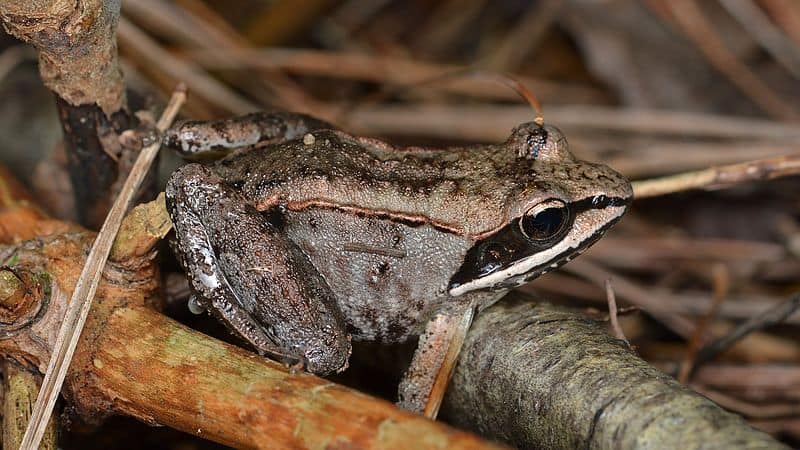Wood Frog Facts
- This unassuming seeming creature holds the common name of the Wood Frog. Its scientific name, however, remains the complicated term of Lithobates sylvaticus. By either name, though, it’s a much more complicated animal than it seems.
- The amazing work of Nature and evolution received that tongue-twisting technical title due to the efforts of John Eatton Le Conte Jr. The respected American naturalist accomplished the first recognition of it as a separate and distinct species in 1825.
- In point of fact, this fascinating amphibian serves as the focus of great attention among many researchers. This degree of attention occurs due to the nature of a truly astonishing evolutionary adaptation displayed by this natural wonder.
- To the complete astonishment of those who first realized it, this frog somehow evolved a method of surviving being partially frozen in winter. This marvel of Nature has, entirely naturally, developed special chemical reactions in its body that allow this.
- This process prevents complete freezing of the water in the cells and bloodstream of the Wood Frog from occurring. As long as no more than 65% of the water in the body freezes, the creature survives. This remains a unique adaptation among its kind.
- Quite fortunately, its population base appears to be stable, at least for the moment. As a result, the IUCN presently lists it as Least Concern on its Red List. The species does, however, remain at risk due to the ongoing and escalating effects of climate change.
Related Articles
Wood Frog Physical Description
The amazing Wood Frog never fails to fascinate those who know of its incredible attributes. These, though, have nothing to do with its size or visual appeal. Evolution provided it with extraordinary traits regardless of any of these so-called normal qualities.
Though sincerely incredible in some ways, the amphibian nevertheless represents an average-sized variety of frog. This example of the resourcefulness of Nature also, like related species, displays a slight degree of the physiological characteristic of sexual dimorphism.
In its case, this trait manifests itself in terms of physical size, not appearance. As a result of this natural tendency, females of the species attain a slightly greater length than males. Overall, however, this length averages between 2.0 – 2.8 in (0.8 – 1.1 cm).
The natural coloring of the Wood Frog further serves to make one mistakenly believe it to be a simple form of amphibian. That’s because this aspect of its nature presents a pattern roughly shared by a great many other frogs throughout the world.
The adult individual typically appears dark brown or varying shades of tan on the upper body. The underside generally shows a pale green or yellow. This animal further, though, possesses the ability to alter its coloring at will as well, within this range of colors.
- Kingdom: Animalia
- Phylum: Chordata
- Class: Amphibia
- Order: Anura
- Family: Ranidae
- Genus: Lithobates
- Species: L. sylvaticus
Wood Frog Distribution, Habitat, and Ecology
Fortunately for it, the impressive Wood Frog inhabits a relatively large area of the globe. More precisely, this natural habitat range consists of a broad range of North America. In fact, this extends from the southern Appalachian Mountains, near the east coast, to Alaska.
The unique amphibian is almost exclusively forest-dwelling by nature, however. It also primarily breeds in woodland vernal pools and freshwater wetlands. When not breeding, though, it may be in or near moist ravines, upland habitats, or freshwater swamps.
Most commonly, adult individuals of the Wood Frog spend the summer and spring in these and various other similar habitats. But, during the fall the animals migrate to neighboring uplands. This is where the majority of this species lives out the winter season.
It also primarily inhabits the upper layer of soil, just beneath layers of leaves. The amphibian further evolved as principally diurnal in nature. Consequently, it rarely emerges at night unless disturbed. At that time, it feeds opportunistically on small invertebrates.
Species Sharing Its Range
Bald Eagle
Check out our other articles on 4 Intriguing New Zealand Insects, Southern Elephant Seal, Perito Moreno Glacier, East African Lowland Honey Bee, Mountain Ebony, Jamaican Iguana

